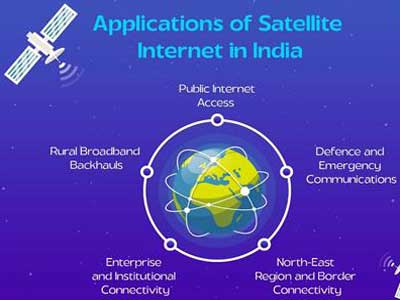India is one of the fastest-growing digital nations in the world, with internet connectivity playing a crucial role in its progress. This momentum is reflected in the staggering 1,002.85 million internet subscribers reported during April–June this year, highlighting the scale and impact of the country’s digital revolution.
However, internet penetration remains limited in certain regions of the country, underscoring the need for satellite internet to complement existing networks. Satellite internet refers to the internet service provided through satellites placed in Geostationary Orbits or Non-Geostationary Orbits.
Read in Hindi: लगातार पट रही है डिजिटल विभाजन की खाई
For realising the Digital India vision of a digitally inclusive nation, satellite internet is an emerging technology with the potential to provide connectivity from space to any location. This makes it particularly valuable for remote villages, hilly terrains, border areas, and islands where terrestrial internet services are either difficult to reach or economically unviable.
Recently, the government introduced a progressive regulatory framework to govern Satellite Communications, aiming to balance innovation with security and spectrum management. New policy measures are shaping an environment that fosters private participation, streamlined approvals, and efficient spectrum utilisation, paving the way for the large-scale adoption of satellite internet.
In 2020, the Government introduced Space Sector Reforms to open the doors for private sector participation in space activities. Building on this momentum, the Indian Space Policy, 2023, established a level playing field for Non-Government Entities in the space sector by enabling their participation across the entire value chain of space activities in an end-to-end manner.
In May, the TRAI released its recommendations on the terms and conditions for assigning spectrum for satellite-based commercial communication services. To balance the regulatory framework with flexibility and efficiency in spectrum utilisation. One of the key recommendations of TRAI is to assign the satellite spectrum for a period of five years, with the option to extend for up to two additional years based on market conditions.
The satellite communication ecosystem is undergoing a transformative shift. Traditionally dependent on the Geostationary Satellite of the Indian Space Research Organisation and other satellite operators’ series, the sector is now witnessing more active private participation and the adoption of next-generation Low Earth Orbit and Medium Earth Orbit satellite systems. With the rollout of space sector reforms, India is set to harness satellite internet as a key driver of Digital India.
With the rollout of space sector reforms, the government now permits up to 100 per cent Foreign Direct Investment in different segments of the space sector through automatic and government approval routes, thereby liberalising entry norms for private participation, marking the transition of India’s satcom landscape.
Marking a major step in strengthening the nation’s digital connectivity landscape, Starlink Satellite Communications Pvt Ltd in June received a license to launch satellite internet services in India. Before it, Jio Satellite Communication Limited and OneWeb India Communications Private Limited have been granted a license for providing such services. As of April, more than 10 satellite operators have shown interest and applied for authorisation to provide satellite capacity in India.
The entry of private-sector players in the space sector marks a significant step towards Viksit Bharat 2047, setting the stage for a seamless rollout of high-speed satellite broadband across the nation. The transitioning Satcom landscape underscores the government’s focus on fostering innovation and next-generation technologies.
The government has launched several initiatives to extend mobile and internet connectivity to the nation's remotest areas, empowering individuals and communities alike. In today’s digital era, such connectivity catalyses socio-economic development, unlocking access to education, healthcare, and economic opportunities.
Under Digital Bharat Nidhi, the government is implementing various schemes for the expansion of broadband facilities through the installation of 4G mobile towers in the rural and remote areas of the country under the 4G saturation project. Further, DBN has been instrumental in funding projects that extend mobile and broadband connectivity to underserved areas.
The government has implemented the Comprehensive Telecom Development Plan for the islands to provide connectivity to the Andaman and Nicobar Islands and Lakshadweep. Satellite Bandwidth Augmentation executed by BSNL increased capacity from 2-4 Gbps in the Andaman & Nicobar Islands and from 318 Mbps to 1.71 Gbps in Lakshadweep. This satellite boost supplements fibre cables to ensure resilient telecom service coverage across the islands.
The government has implemented CTDP to provide mobile connectivity to villages and areas along National Highways to extend mobile network access to the underserved population. As of June, 2,485 mobile towers have been commissioned, providing mobile connectivity to 3,389 locations.
National Broadband Mission 2.0 was launched on January 17, after the successful completion of NBM 1.0, to extend broadband services to the remaining 1.7 lakh villages across the country. The NBM 2.0 aims to propel India into a new era of digital transformation and global competitiveness, aligning with the vision of Viksit Bharat.
Funded under DBN, BharatNet is an ambitious project aimed at providing affordable high-speed internet access to every Gram Panchayat in the country, bridging the gap between urban and rural communities. The satellite component of this project is being implemented by Bharat Broadband Network Limited and BSNL under Phase II. So far, over 2.14 lakh Gram Panchayats are connected through the BharatNet project, with BSNL covering 1,408 and BBNL covering 3,753 of them.
Prime Minister Wi-Fi Access Network Interface is designed to create a network of public Wi-Fi hotspots across India. It aims to make affordable and reliable internet access available to citizens, fostering digital participation and economic opportunities. More than 3.73 lakh PM-WANI Wi-Fi hotspots have been installed in the country, as of September.
The Ministry of Earth Sciences has developed a Geographic Information System-based Decision Support System. It uses internet connectivity to deliver timely and impact-based early warnings for extreme weather events. The system relies on historical data, real-time observations, radar, and satellite imagery. It helps disaster-prone states monitor risks and take measures to protect lives, livelihoods, and infrastructure. Together, these efforts underscore India’s commitment to employing satellite communication to strengthen digital infrastructure and improve public services.
India’s broadband reach is steadily expanding through high-throughput satellites developed by ISRO, which use advanced spot-beam technology to provide faster speeds and higher capacity. India has a fleet of 19 operational communication satellites, among which GSAT-19, GSAT-29, GSAT-11, and GSAT-N2 are specifically geared towards boosting India’s broadband services. These satellites are designed to enhance internet connectivity in underserved areas, support in-flight communication, defence networks and disaster management. Together, they form the backbone of satellite-based broadband infrastructure in India, complementing ground-based networks like BharatNet.
In line with the vision of Viksit Bharat 2047, satellite internet is emerging as a key enabler of digital connectivity, extending reliable access to remote and underserved regions, while strengthening critical applications in defence and disaster response. Through the power of space technology, India is reinforcing its strategic autonomy and leadership in space-based communications, ensuring that the benefits of connectivity reach every citizen. From operationalising HTS to enabling private participation in satellite communications, the country is steadily bridging its digital divide.


















Related Items
Redefining Indian Highways; Driving innovation, Delivering connectivity…
India stuck in traffic; Cities halt, Horns holler, and time takes a nap
India’s deep dark fraud economy unveiled…